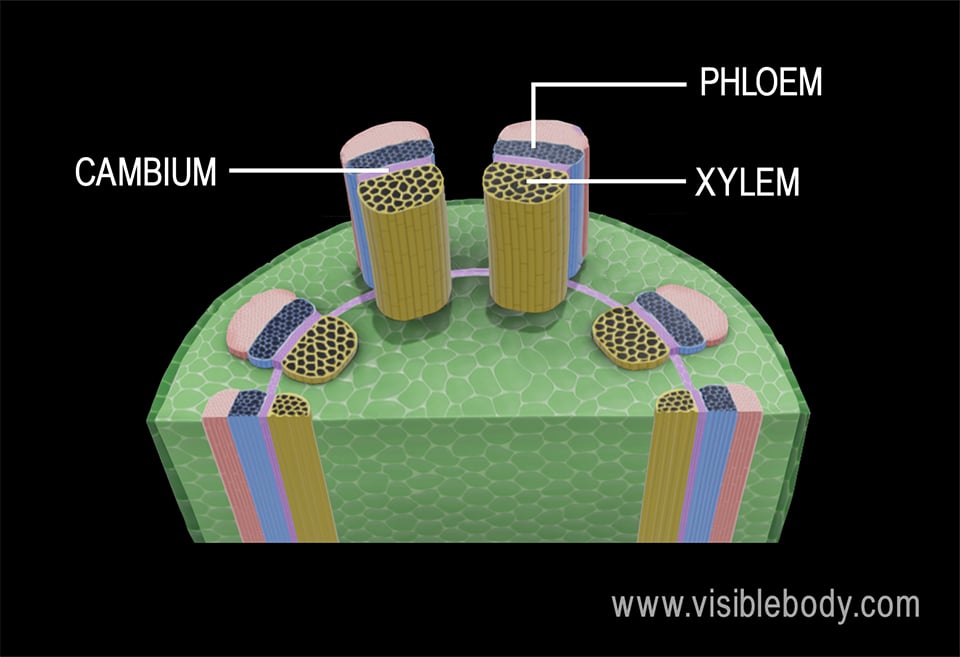The stem supports the plant, holding up the plant’s leaves, flowers, and fruits. Within the stem, bundles of vascular tissue, consisting of xylem and phloem, transport water, nutrients, food, and other chemicals between the different parts of the plant. The xylem transports water and dissolved minerals from the roots to the stem and leaves. The phloem transports dissolved sugars and organic compounds from the leaves to the stem and roots.
Cambium (present in dicots but not monocots) gives rise to secondary xylem and phloem.

In both monocots and dicots, the stem is mostly composed of ground tissue, which contains loosely arranged cells with space between them. This allows for gas exchange between the stem and the air.
Like monocot roots, monocot stems are protected by an outer layer of dermal tissue called the epidermis. The rest of the stem is made up of ground tissue and vascular tissue.
The vascular tissue is arranged into bundles of xylem and phloem that are scattered throughout the ground tissue. Within each bundle, the phloem is located closer to the outside of the stem, and the xylem is located closer to the inside of the stem.
Like dicot roots, dicot stems are protected by an outer layer of dermal tissue called the epidermis. Then, also similar to dicot roots, dicot stems have a layer of ground tissue called the cortex beneath the epidermis. The vascular bundles in the stem are arranged around a ring of cambium, which contains cells that divide to expand the girth of the stem. This is similar to the function of the cambium in dicot roots.
Within the vascular bundles, the xylem is located interior to the cambium ring, and the phloem is located exterior to the cambium ring, accompanied by sclerenchyma ground tissue. The ground tissue located interior to the cambium ring is referred to as the pith.
There are two types of plant growth, and the stem plays an important role in both of them.
Primary growth occurs in all groups when a plant grows taller and when it develops roots, branches, leaves, and flowers. Plants that undergo only primary growth and have soft, green, non-woody stems are known as herbaceous plants. They typically have an annual, biennial, or perennial life cycle, meaning that they partially or completely die after a season and have to re-grow.
Secondary growth occurs when dicot stems and roots grow wider. Frequently, this involves the development of a woody stem, which arises from a combination of the activities of the stem’s vascular cambium and cork meristem tissues. However, not all dicots that undergo secondary growth have woody stems—for example, tomato, carrot, and potato plants don’t have woody stems but they do undergo secondary growth.
In general, monocots do not undergo secondary growth. If they do increase in girth (like palm trees and yucca plants), it does not result in the development of a secondary xylem and phloem, since monocots don’t have vascular cambium. An increase in girth without secondary growth is referred to as anomalous thickening.
An article from Georgia Tech summarizing the differences between primary and secondary growth. Also contains videos!
When you select "Subscribe" you will start receiving our email newsletter. Use the links at the bottom of any email to manage the type of emails you receive or to unsubscribe. See our privacy policy for additional details.